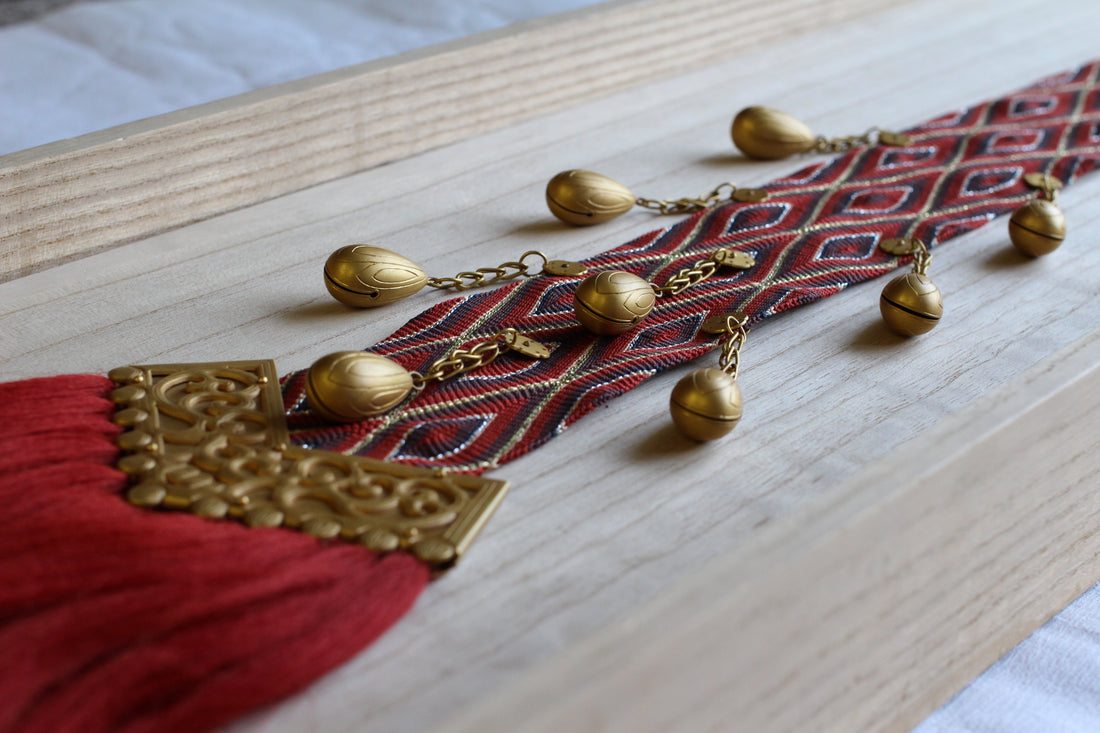Edo period
Ikenohata, where Domyo Honten is located, has long been a bustling town where the townspeople have formed at the base of Yushima Tenjin. In the Edo period, Kan'eiji Temple, which was likened to Enryakuji Temple on Mt.
In the Edo period, shops dealing in braided cords were included in the category of business called yarn dealers, along with shops dealing in twisted yarn. Since its founding in 1652, Domyo has continued to make a living as a yarn dealer. There is no clear record of its founding, but it is said that a feudal retainer of the Takada domain in Echigo quit his samurai role and became a townsman and opened the shop.
Then, in the middle of the 18th century, the head of the family at that time took the name Domyo Shinbei the first. He has passed through the generations and is now the tenth generation. At that time, there was a great demand for braided cords as the cords and handle threads for samurai swords, and it is said that there were many thread dealers in the city of Edo. And it was mainly the craftsmen of the thread dealers who made the braids distributed there. In addition, one of the leaders in braiding technology research was the samurai of Edo. At that time, the samurai were taught that they should make their own weapons by themselves, and braiding braids was considered one of the skills of the samurai. Kumihimo techniques described in military science texts such as "Togeki Kyuyo" and "Hyakko Hisho" are valuable materials for understanding the techniques of the time.

In the middle of the Edo period, the life of the samurai became difficult in contrast to the prosperity of the townspeople's culture. For economic reasons, braiding techniques were handed down as a side job for the samurai. According to his grandfather, the 7th Domyo Shinbei, his grandfather, the 5th Domyo Shinbei, often visited samurai homes around the end of the Edo period to ask for braided cords. Since the middle of the Edo period, the technique of braiding braids has been very advanced, backed by historical and technical research of the samurai, and it seems that high-quality braids began to be produced in Edo.

Meiji, Taisho period
In the Meiji era, Edo changed to Tokyo, and many changes came. The number of craftsmen who colored the townspeople's culture in Edo decreased, and manufacturing shifted to heavy industrial factory production. In the Edo period, work and home were the basics, and manufacturing was actively carried out in the center of Edo. , gradually moving to the suburbs of Tokyo. Of course, some small-scale places for handicrafts remained in central Tokyo, albeit gradually decreasing in number. Tokyo has changed.
In the midst of this, Domei devoted himself to the research and production of braids while preserving the handiwork of craftsmen in Ikenohata. However, due to the ban on swords, the demand for braided cords for sword straps and handle threads disappeared, so the main product handled by thread dealers shifted to obijime, which was becoming indispensable for women's kimono. increase. In the Meiji period, narrow braids and metal fittings were mainly used for obijime, but gradually, thick and thick braids, which were also used for sword straps, came to be used as obijime. Many of the lower straps were made with the best of braiding techniques, and it was from the Meiji to Taisho eras that obi-jime became synonymous with braids.

Obijime in the early days
From its founding to the present day, Domyo is by no means a large-scale yarn dealer. In the ranking table of yarn dealers based on the trading volume of braids issued in 1878, it is on the ninth page in the front of the west. Ikebata-Nakacho The name written as Echizenya Shinbei is Domyo, and it used to be called Echizenya. As of the 10th year of the Meiji era, there were still many yarn dealers in Tokyo, from major braid shops to individual shops. If anything, Domyo was not a general store, but a store that was known only to those in the know, supported by a limited number of enthusiasts.

Yarns Sakae Ranking Table

In such an environment, Domyo has created a variety of Kumihimo based on his own aesthetic standards and released them to the world as products such as Obijime and Haorihimo. Obijime that incorporates the design of various historical braids continues to line up in stores even after nearly 100 years.

Showa period
Entering the Showa era, the number of braids made by handwork by craftsmen decreased, and it was also an era when mass-produced braids using machines became popular. From crafts handed down secretly in craftsmen's workshops to Kumihimo as a general spread technique, Kumihimo as an industrial product was widely used along with textile technology such as textiles and knitting that had been modernized and industrialized earlier. It is now used for various purposes. However, on the other hand, hand braided braids have not been completely replaced by machine braids, and have continued to be made to this day as valuable products.

Showa prewar store






Heisei period
Domyo is located in Ikenohata in Ueno, Tokyo. The new head office, which was completed in February 2016, is a five-story building that expresses the design of traditional Japanese architecture with concrete construction. We aimed to create an architecture that is modern yet classic, functional yet emotional, and has various ambiguities. The Kumihimo archive, the dyeing room, the design room, and the workshop, each floor carries out the Kumihimo process in order from the upper floor, and the completed Kumihimo is sold at the store on the first floor, just like a tool for making Kumihimo. It works as a building.



